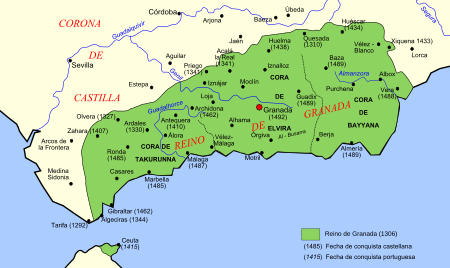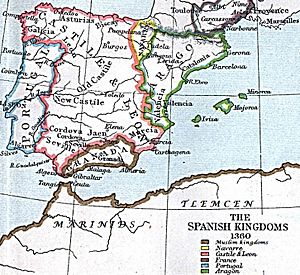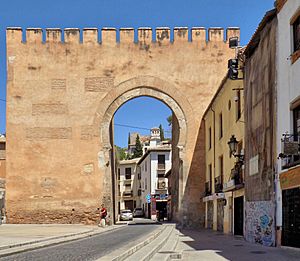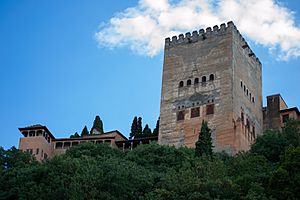Nasr of Granada facts for kids
Quick facts for kids Nasr |
|||||
|---|---|---|---|---|---|
| Sultan of Granada | |||||
| Reign | 14 March 1309 – 8 February 1314 | ||||
| Predecessor | Muhammad III | ||||
| Successor | Ismail I | ||||
| King of Guadix (self-proclaimed) | |||||
| Reign | February 1314 – November 1322 | ||||
| Born | 1 November 1287 Granada, Emirate of Granada |
||||
| Died | 16 November 1322 (aged 35) Guadix, Emirate of Granada |
||||
|
|||||
| House | Nasrid dynasty | ||||
| Father | Muhammad II | ||||
| Mother | Shams al-Duha | ||||
| Religion | Islam | ||||
Nasr (born November 1, 1287 – died November 16, 1322), whose full name was Abu al-Juyush Nasr ibn Muhammad, was the fourth ruler of the Nasrid dynasty in the Emirate of Granada. He ruled from March 14, 1309, until he gave up his throne on February 8, 1314.
Nasr became sultan after his brother, Muhammad III, was removed from power in a sudden change within the palace. When Nasr took over, Granada was facing a tough war against three powerful neighbors: Castile, Aragon, and the Marinid Sultanate. These conflicts started because of his brother's foreign policies.
Nasr quickly made peace with the Marinids in September 1309. He gave them the port city of Ceuta in Africa, which they had already captured. He also gave them Algeciras and Ronda in Europe. Granada lost Gibraltar to Castile in September after a siege. However, Granada successfully defended Algeciras until it was given to the Marinids, who continued to defend it until the siege ended in January 1310.
James II of Aragon asked for peace after Granada's defenders successfully stopped the Aragonese siege of Almería in December 1309. Aragonese forces left Granada's lands by January. In the peace treaty that followed, Nasr agreed to pay money and give up some border towns to Ferdinand IV of Castile in exchange for seven years of peace.
Even though Nasr brought peace with few losses, he was not popular at court. Some people thought he favored Christians. Others accused him of spending too much time studying astronomy and neglecting his duties as ruler. A rebellion started by his brother-in-law, Abu Said Faraj, in 1311 was stopped at first. But a second attack by Abu Said's son, Ismail, led to the capture of the Alhambra palace. Nasr was forced to give up his throne on February 8, 1314, to Ismail, who became Ismail I.
Nasr was allowed to rule the eastern province of Guadix, calling himself "King of Guadix." He tried to get his throne back with help from Castile. However, Ismail defeated the Castilian forces in the Battle of the Vega of Granada. This led to a truce that ended Castile's support for Nasr. Nasr died in 1322 without any children to inherit his claim.
Contents
Early Life and Family
Nasr was born on November 1, 1287, likely in the Alhambra. The Alhambra was the royal palace and fortress of the Nasrid dynasty in Granada. His father was Muhammad II, who ruled as the second Nasrid Sultan of Granada from 1273 to 1302. Nasr's mother was Shams al-Duha, his father's second wife, who was a Christian and a former slave.
Muhammad II had other children from his first wife. These included his firstborn son, Muhammad (who later became Muhammad III, born in 1257), and his daughter Fatima (born around 1260). Their father, Muhammad II, was known as "al-Faqih" (the canon-lawyer) because he was very learned. He encouraged his children to study. Muhammad III was interested in poetry, Fatima studied the writings of Islamic scholars, and Nasr studied astronomy. Nasr's older brother, Muhammad, was named the heir to the throne during their father's reign.
Muhammad III became sultan after their father died in 1302. Towards the end of his rule, Granada was almost at war with a powerful alliance. This alliance included the Christian kingdoms of Castile and Aragon in Spain, and the Marinid Sultanate in North Africa. This dangerous situation, along with the expensive lifestyle of the chief minister, Ibn al-Hakim, made the people of Granada angry.
On March 14, 1309, a group of Granadan nobles, including Ibn al-Hakim's rival, Atiq ibn al-Mawl, started a sudden change in power. They forced Muhammad III to give up his throne in favor of Nasr. Muhammad III went to live on an estate in Almuñécar. Ibn al-Hakim was killed during the unrest, and his body was disrespected by an angry crowd. Nasr became the new sultan and made Ibn al-Mawl, who started the change, his chief minister.
War Against Three Kingdoms
When Nasr became ruler, Granada was in a very difficult spot. It had no allies and three powerful enemies preparing for war. One of the main reasons for the conflict was Granada's control of Ceuta. Ceuta was a port city on the North African coast near the Strait of Gibraltar. It had rebelled against the Marinids in 1304 and was captured by Granada in 1306.
Granada's control of Ceuta, along with its control of Algeciras and Gibraltar (other ports in the Strait), and Málaga and Almería further east, gave it strong power over both sides of the Strait. This made the Marinids, Castile, and Aragon unhappy.
The Marinids attacked Ceuta on May 12, 1309. They formed an alliance with Aragon in early July. Aragon agreed to send ships and soldiers to help the Marinids take Ceuta. In return, Aragon would receive wheat and barley, get trade benefits in Morocco, and both sides agreed not to make a separate peace. The agreement also stated that once Ceuta was captured, it would go back to the Marinids. However, Aragon would first get to take all valuable goods from the port.
But on July 20, 1309, the people of Ceuta removed their Granadan rulers and allowed the Marinids to enter the city without Aragon's help. With Ceuta back under Marinid rule, they became less hostile towards Granada. The two Muslim states then began talks. Nasr had already sent messengers to the Marinid court in Fez in April. By late September 1309, a peace agreement was reached. Nasr accepted Marinid rule over Ceuta. He also had to give up Algeciras and Ronda in Europe, along with their surrounding areas. This meant the Marinids once again had bases in Granada's traditional lands in southern Spain.
Since the Marinids no longer needed Aragon's help, they ended their alliance. They also did not send the promised treasure from Ceuta. Soon, King James II of Aragon wrote to the Castilian king, Ferdinand IV, saying that the Marinid Sultan could now be considered an enemy.
Meanwhile, at the end of July 1309, Christian forces, including troops from Castile, Aragon, and Portugal, began to surround Algeciras. This port city was in the western part of Granada. King Ferdinand IV led this siege. Soon, a part of this force also surrounded nearby Gibraltar. Two siege machines attacked Gibraltar's walls, while Aragonese ships blocked its port. The city surrendered on September 12, 1309, just before Nasr made peace with the Marinids. Gibraltar's mosque was turned into a church. About 1,125 of its people left for North Africa rather than live under Christian rule. Although Gibraltar was less important than Algeciras, its capture was still important. It gave Castile a key position on the Straits of Gibraltar. Gibraltar would return to Muslim control in 1333, and then to Castile again in 1464.
The siege of Algeciras continued. As part of the Granada–Marinid peace deal, the city was given to the Marinids. The soldiers defending it now fought for the Marinids. The Marinids sent troops and supplies to strengthen the city. Nasr then focused his attention on the eastern front. In late October or November, 500 Castilian knights, led by the king's uncle Infante John and the king's cousin Juan Manuel, left the siege of Algeciras. This discouraged the remaining besiegers and made them open to a counterattack. Ferdinand IV was still determined to continue the siege. He said he would rather die in battle than withdraw from Algeciras in dishonor.

On the eastern front, Aragonese troops surrounded Almería, with some help from Castile. The city had managed to gather supplies and improve its defenses because the Aragonese forces, led by James II, arrived late by sea in mid-August 1309. Several attacks on the city failed. Nasr sent troops under Uthman ibn Abi al-Ula to help Almería. They took a position in nearby Marchena after defeating an Aragonese group there. They constantly bothered the besiegers' groups that were looking for food. By the time winter came, the city still held out. The weakening of the Algeciras siege in November meant Granada could send more help to the east.
At the end of December, James II and Nasr agreed to a truce. The Aragonese king would remove his troops from Granada's lands. The removal was finished in January 1310 after some small problems. At one point, Nasr wrote to James that the city's defenders had to hold the remaining Aragonese troops. This was because they were stealing from Granada's lands. Nasr also noted that the Muslims gave them housing and food at their own cost "because some of them were starving" while waiting for the Aragonese ships to pick them up.
Ferdinand IV's siege of Algeciras made little progress. By January 1310, he ended the siege and began talks with Nasr. Fighting still continued. For example, Castilian troops under the king's brother, Infante Peter, captured Tempul (near Jerez). The Castilian-Aragonese fleet still patrolled Granada's waters in May.
A seven-year peace treaty was signed on May 26, 1310. Nasr agreed to pay 150,000 gold coins and an annual payment of 11,000 coins to Castile. In addition to Gibraltar, Granada gave up some border towns, including Quesada and Bedmar. These towns had been gained by Muhammad III in the previous war. Both kings agreed to help each other against their enemies. Nasr became a vassal (a ruler who owes loyalty and service) to Castile. He was to provide up to three months of military service each year if called upon, using his own troops and paying his own expenses. Markets would be opened between the two kingdoms. Ferdinand IV was to appoint a special judge for the borders to settle disagreements between Christians and Muslims in those areas.
There are no historical records of a Granada-Aragon treaty. However, it is known that Nasr agreed to pay James II 65,000 coins as payment. Ferdinand IV was supposed to give 30,000 of these.
The Marinid presence in Spain did not last long. Abu al-Rabi died in November 1310. He was replaced by Abu Said Uthman II, who wanted to expand his lands in Spain even more. He sent a fleet across the strait, but Castile defeated it near Algeciras on July 25, 1311. He decided to withdraw and returned his Spanish lands, including Algeciras and Ronda, to Nasr.
Rebellion and Losing the Throne
Even though Nasr successfully ended the three-front war with minimal losses, he and his chief minister, Ibn al-Hajj, soon became unpopular. Ibn al-Hajj had replaced Ibn al-Mawl, who had fled to North Africa. Historians are not entirely sure why they became unpopular. Some suggest it was because Nasr spent too much time on science, which his nobles thought was excessive. Also, people suspected Nasr and his chief minister of favoring Christians.
Nasr was said to spend too much time building astrolabes (tools for astronomy) and making astronomical tables. People felt he was neglecting his duties as ruler. The suspicion of favoring Christians came from his education by his Christian mother and his good relationship with Ferdinand IV. Ibn al-Hajj was also unpopular because people believed he had too much power over the sultan. To make matters worse, both Nasr and Ibn al-Hajj often dressed in the Castilian style.
In November 1310, Nasr became very ill. A group at court tried to bring Muhammad III back to power. The old and nearly blind former sultan was brought from Almuñécar. But the plan failed when Nasr recovered before Muhammad could be put on the throne. Nasr then imprisoned his brother in the Alhambra palace. Nasr later had his brother drowned. There are different reports about when this happened, but it was likely on January 21, 1314.
The next rebellion was led by Abu Said Faraj. He was the governor of Málaga and a member of the Nasrid royal family. He was a nephew of Muhammad I, who founded the emirate. He was also Nasr's brother-in-law, as he was married to Nasr's sister, Princess Fatima. When Abu Said visited Nasr, he saw that the sultan was unpopular. He also disliked what he heard about Nasr, especially the death of Muhammad III.
Abu Said started his rebellion in Málaga in 1311. Instead of claiming the throne for himself, he declared his son, Ismail, as the rightful ruler. Ismail had a stronger claim because he was the grandson of Muhammad II through his mother Fatima. Rebels from Málaga were supported by North African forces. Other North African forces supported Nasr. The rebels captured Antequera, Marbella, and Vélez-Málaga. They advanced to the Vega of Granada and defeated Nasr's forces in a battle. During this battle, Nasr fell from his horse and had to run back to Granada on foot.
Abu Said then surrounded the capital, but he did not have enough supplies for a long siege. Nasr asked Ferdinand IV for help. Castile's forces, led by Infante Peter, defeated Abu Said and Ismail on May 28, 1312. Abu Said sought peace and was allowed to keep his position as governor of Málaga. He also continued to pay tribute to the sultan. Later, Nasr also paid his annual tribute to Castile in August 1312. Soon after, Ferdinand IV died and his one-year-old son, Alfonso XI, became king.
Opposition to Nasr continued. Members of the anti-Nasr group fled the court to Málaga. Soon, Ismail restarted the rebellion with help from his mother Fatima and Uthman ibn al-Ula. As Ismail moved towards Granada, his army grew larger. The people of the capital opened the city gates for him. Ismail entered the city through the Elvira Gate and surrounded Nasr, who was still in the Alhambra. Nasr tried to ask Infante Peter for help, but aid did not arrive in time. Nasr was forced to give up his throne on February 8, 1314. In exchange for surrendering the Alhambra, he was allowed to leave for Guadix and rule there as governor.
Efforts to Regain the Throne
After Nasr's defeat and move to Guadix, he still claimed to be the rightful ruler. He called himself "King of Guadix" and led a group of his relatives and servants to resist Ismail. Ismail surrounded Nasr at Guadix in May 1315 but left after 45 days. Nasr repeatedly asked Castile for help. Castile was ruled by a group of regents (people who govern for a young king), including Infante Peter, Infante John, and the king's grandmother María de Molina. Peter agreed to meet Nasr and help him. However, he also secretly told James II of Aragon that he planned to conquer Granada for himself. He offered to give one-sixth of it to Aragon in exchange for help. In January 1316, Nasr told James II again that the upcoming military campaign was to put him back as Sultan of Granada. Nasr offered to give Guadix to Peter if Nasr succeeded in retaking the throne.
Castile's preparations for the campaign began in the spring of 1316. On May 8, Granadan forces under Uthman ibn Abi al-Ula stopped a Castilian group supplying Nasr, who was again surrounded at Guadix. A battle then took place near Alicún. In this battle, Castilian forces led by Peter, and supported by Nasr, defeated the Granadan royal forces. They killed 1,500 soldiers and forced them to retreat to Granada.
After this, the war continued for several years, with short truces (temporary stops in fighting). The most important part of the war happened on June 25, 1319. A Granadan force led by Ismail fought the Castilian army in the Vega of Granada. The Castilian commanders and regents, John and Peter, both died during the battle without fighting. They may have died from heart attacks. Ismail's forces then completely defeated the discouraged Castilian forces.
The defeat and death of the two regents left Castile without leaders. This caused internal problems and gave Ismail the upper hand. Because there was no royal leadership, the Hermandad General de Andalucía (a group of frontier towns) stepped in to negotiate with Granada. A truce was agreed upon by this group and Ismail on June 18, 1320. It was meant to last for eight years. One of the rules was that the Castilians would not help any other Moorish (Muslim) king. This meant the end of support for Nasr.
Nasr died in Guadix without any children on November 16, 1322, at the age of 35. His death ended the direct male line of the Nasrid dynasty from Muhammad I, who founded the emirate. Future Sultans of Granada would come from Ismail's family branch. Ismail's father was from a different branch of the dynasty, but his mother Fatima was Muhammad I's granddaughter. Nasr's lack of an heir helped keep the dynasty united for a while. Ismail peacefully took back the lands that were under Nasr's control into the Emirate. Nasr was first buried at the main mosque of Guadix. Later, his body was moved to the Sabika Hill of the Alhambra, next to his grandfather Muhammad I and brother Muhammad III.
Character and Contributions
Official writings describe Nasr as elegant, gentlemanly, pure, and peace-loving. He was very knowledgeable in astronomy. He was taught by Muhammad ibn al-Raqqam (1250–1315), an astronomer from Murcia who moved to Granada at the invitation of Muhammad II. Nasr himself wrote various almanacs and astronomical tables. He also supported a famous doctor of his time, Muhammad al-Safra of Crevillente. This doctor followed him to Guadix as his personal physician after Nasr lost his throne.
Nasr was responsible for building the Tower of Abu al-Juyush in the Alhambra. This is a rectangular tower that rises above the city wall built by Muhammad II. It is connected to the wall by a hidden staircase that also leads to an underground path out of the palace complex. Today, it is better known as the location of the Peinador de la Reina (The Queen's Dressing Room). This name came from its use by Isabella of Portugal, the wife of Emperor Charles V. The tower was likely used and improved by Nasr's successors. Yusuf I, who was the son of Ismail I (the one who removed Nasr from power), tried to replace Nasr's name in the tower with his own.
For both old and modern historians, Nasr giving up his throne to Ismail I marked an important change. It was the end of "the Nasrid dynasty of al-Ghalib," whose rulers were directly descended from Muhammad I (also known as "al-Ghalib billah"). It was the beginning of a new branch: "the Nasrid dynasty of Ismail." The Nasrid dynasty did not have a specific rule for who would become ruler next. However, Ismail I was the first of only a few rulers who were only related to the royal line through their mother. The other time this happened was in 1432 with Yusuf IV.
See also
 In Spanish: Nasr para niños
In Spanish: Nasr para niños




